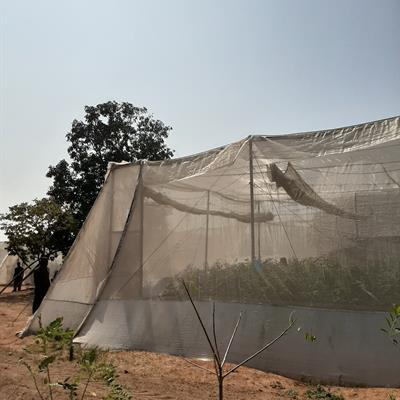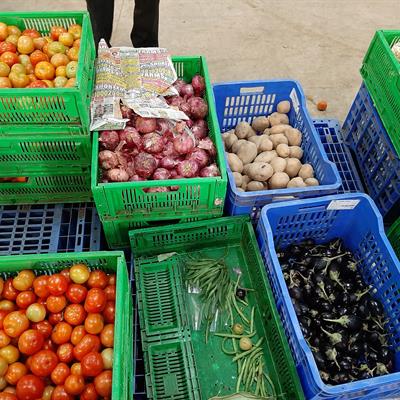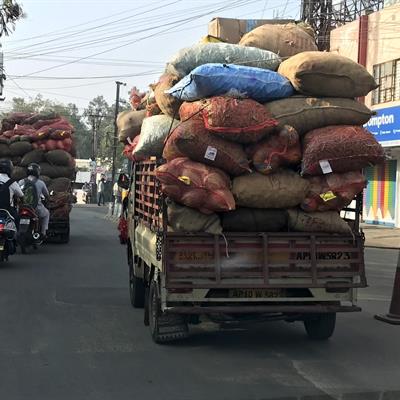The project is being funded by STFC and the Global Challenges Research Fund (GCRF) which supports research to address the challenges faced by developing countries. The project draws of expertise from across STFC. RAL Space thermal engineers are bringing their expertise in passive methods to cool space instruments to the problem. Earlier this month they travelled to Hyderabad in India to see first-hand the challenges facing farmers and suppliers there.
Katherine Ostojic is one of the thermal engineers working on the project. This is her account of the fieldwork in Hyderabad.
We arrived with time to overcome our jetlag before the meetings commenced. Alongside some other British participants, we braved the 30֯C heat of Indian winter and the adrenaline rush of crossing roads there to explore the local area. This was my first visit to India and before coming I'd only read papers about food distribution, so it was very different seeing it in real life.
The first day of the meeting was our opportunity to meet the rest of the project team, over 25 members from India and the UK, each of whom brings a different specialty to the project, from data science to organic farming. The preliminary results from the project were shared with the group, showing the multistage process by which vegetables travel from the farm to the customer.
The next day, we set off to the countryside surrounding Hyderabad to visit a selection of farms with differing methods of growing tomatoes. This gave us an idea of the materials currently being used to shield the produce from the Sun. Layers of netting, for example, were being used to shade the plants as they grew while allowing air to flow.
We collected samples of materials to give us an idea of what is available locally and at an accessible price for farmers. Back in the UK we will test the thermal surface properties of the materials - how much of the Sun's heat they absorb. We will use our expertise in passive thermal control and material thermal properties from cooling space instruments to find out if the materials being used on the farms are effectively cooling vegetables, and suggest possible alternatives.
 We also went to loud and busy distribution centres where tuktuks piled high with vegetables were arriving to have their produce sorted to be sent to market. In the countryside, many of these warehouses are open to the elements and so the vegetables aren't kept cool. In the UK, about 70% of food is moved through the 'cold chain'. In India it is only about 4%. Only one of the distribution centres we saw had refrigeration units for their higher value produce, the first point in the food chain where the vegetables were being cooled in order to preserve them.
We also went to loud and busy distribution centres where tuktuks piled high with vegetables were arriving to have their produce sorted to be sent to market. In the countryside, many of these warehouses are open to the elements and so the vegetables aren't kept cool. In the UK, about 70% of food is moved through the 'cold chain'. In India it is only about 4%. Only one of the distribution centres we saw had refrigeration units for their higher value produce, the first point in the food chain where the vegetables were being cooled in order to preserve them.
Part of the project is to investigate how innovations might be implemented in practice. We will examine whether the materials being used at the farms are worth introducing during transportation and storage as vegetables travel from farm to plate. Our solutions have to be affordable and practical for people to use in India.
On the last day, we reconvened with our teams in order to update our project plans having seen all the different parts of the food chain.
During the next year, we will be finding solutions to the issue of food wastage in the supply chain due to the lack of cold transportation in India. Our team includes a company in India testing the optimum conditions to transport tomatoes, and a local materials supplier who will be advising us on the locally available materials which could form part of our solution. The RAL Space team will use the temperature data gathered from farms to develop a storage solution which we will test in our labs here and hopefully on the ground in India.
This is a huge challenge, and a long way from the cleanrooms where we work to wrap spacecraft in the shiny, expensive materials which protect them from the extreme temperatures of space. I'm excited about getting stuck into the project. Going to India has opened my eyes to the big impact that this project could have to the lives of the farmers who make up 70% of India's population.

Images
Top: Farm near Hyderabad using netting to shade crop growth. Credit: STFC RAL Space
Middle: Fruits and vegitables uncovered at a distribution centre in Hyderabad. Credit: STFC RAL Space
Bottom: Food transportation in Hyderabad. Credit: STFC RAL Space
